
D. H. Burnham & Company in Pittsburgh
By Albert M. Tannler, Historical Collections Director (1991-2019)
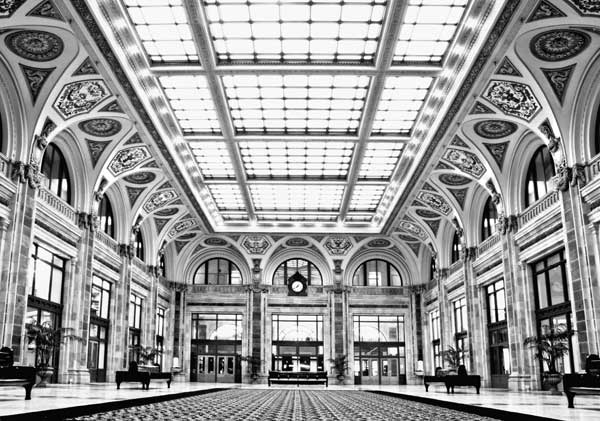
Union Station Waiting Room. Photo by Todd Tondera.
How many buildings designed by D. H. Burnham & Company of Chicago were erected in Pittsburgh? The question was brought to my attention in April 2008 when architectural film maker Judith Paine McBrien of The Archimedia Workshop, Chicago, invited me to a Pittsburgh preview of her forthcoming documentary film, Make No Little Plans: Daniel Burnham and the American City, to be shown in September 2009. The question was especially pertinent as Lu Donnelly, editor and principal author of the forthcoming Buildings of Pennsylvania: Pittsburgh and Western Pennsylvania (Society of Architectural Historians, 2009) was preparing her book for publication and sought accurate information about Burnham buildings in Western Pennsylvania.
The most recent study of architect Daniel H. Burnham (1846-1912), Daniel H. Burnham: Visionary Architect and Planner, by Kristen Schaffer (2003), states: “In Pittsburgh alone, the firm designed some twenty buildings, and constructed seventeen, between 1898 and 1912.” [148]. Her source is Franklin K. Toker, Pittsburgh: An Urban Portrait (1986); the claim [40], however, is undocumented. Walter C. Kidney, Landmark Architecture (1985) did not address the number of commissions but posited 16 executed buildings; in the 1997 revision he increased the number to 17, a number I too have cited on architecture tours.The numbers, derived from earlier scholarship, require further scrutiny.
The first major study of Burnham, Daniel H. Burnham, Architect, Planner of Cities, by Burnham friend and collaborator Charles Moore (1921) provides a chronological list of buildings by completion date. Moore lists 15 Burnham buildings in Pittsburgh. Architectural historian Thomas S. Hines, Burnham of Chicago: Architect and Planner (1974) attempted to revise and correct Moore’s list. Hines’ list enumerated 16 buildings, including Union Station which Moore omitted from his list but discussed in his text; Hines also revised some dates and incorrectly changed Virgin Avenue to “Virginia” Avenue. Unlike Moore, Hines did not identify clients. Otherwise, both lists are identical. Both include an unidentified cemetery monument for R. Trimble [1908]; a possible client is Robert Trimble [b. 1856], chief engineer of maintenance for the Pennsylvania Company and a founding member of the Engineers’ Society of Western Pennsylvania.
Hines provides a detailed description of source materials, most notably the Burnham collection at the Burnham and Ryerson Library, The Art Institute of Chicago, in “On Sources” [387-400]. Although references to Burnham commissions and buildings in Pittsburgh are found in diaries and letters (some are quoted by Moore), no blueprints, drawings, or specifications are preserved in the D. H. Burnham Collection (now searchable online). There are, however, 1903 shop drawings for the Wood Street Building in the Ernest R. Graham Study Center for Architectural Drawings, Department of Architecture and Design, The Art Institute of Chicago.
Burnham clients in Pittsburgh included the Pennsylvania Railroad, the Western Pennsylvania Exposition Society, and the First National Bank who each commissioned one building; Henry Clay Frick who commissioned four buildings: and Henry W. Oliver who is said to have commissioned nine buildings.
The buildings commissioned by Henry Clay Frick are extensively documented at the Frick Art Reference Library in New York, including the Frick Monument (1901-03) in Homewood Cemetery, not included on the Moore/Hines lists. (Lu Donnelly kindly shared copies of documents relating to Burnham’s Frick commissions in Pittsburgh that she received from the Frick Art Reference Library.) A major collection of material related to Henry Clay Frick’s buildings in Pittsburgh was transferred to the Archives Service Center of the University of Pittsburgh Library by the Frick Art Reference Library and may be consulted by appointment. The Carnegie Mellon University Architecture Archives has copies of drawings pertaining to Union Station. Some Burnham buildings in Pittsburgh are documented in national and regional architectural journals, and in regional newspapers, magazines, guide books, and commemorative civic publications.
It is the list of buildings said to have been commissioned by Henry W. Oliver (1840-1904) that has led to numerical confusion:
- Commercial Gazette Building (designed and erected c. 1901-03)
- Wood Street Building (designed and erected 1902-04)
- McCreery & Company building
- Third National Bank (designed and erected 1903)
- Virgin Avenue building (Hines has Virginia Avenue; the correct name is Virgin Alley although Virgin Avenue was occasionally used)
- Oliver Avenue building
- [Henry W.] Oliver building (designed and erected 1907-10)
- Stewart building
- Liberty Avenue building
As we read the names of the buildings on this list more carefully, several things become apparent:
- the Wood Street Building and McCreery & Company are two entries; they are, however, one building; the New York department store was the first tenant and opened its Pittsburgh branch in the Wood Street Building in 1904;
- the Virgin Avenue [Alley] building (1903) and the Oliver Avenue building [1906]; and the Oliver building [1908] are listed as three different buildings, but are however the same commission for one building initially located on Virgin Alley, which was renamed Oliver Avenue in 1904; the building was subsequently erected and named in memory of the client as the Henry W. Oliver Building (designed and erected 1907-10).
We are left with two unidentified attributed commissions: the Stewart Building [1903], and the Liberty Avenue Building [1906]; the first for Henry W. Oliver, the second for the Oliver Estate.
It is the Oliver commissions that are listed more than once, as is shown above, or that remain unverified. Oliver was responsible for the Commercial Gazette Building and the Wood Street Building (which he did not live to see finished); he initiated the commission that resulted in the Oliver Building, and—although Moore does not list him as the client—Oliver also commissioned the Third National Bank. Unfortunately Oliver left no archive as such. There is useful information in a scrapbook in the Oliver Iron and Steel Company Records at the University of Pittsburgh Library’s Archives of Industrial Society. There are building permits, plat maps, and city directories. There are books such as J. Cutler Andrews, Pittsburgh’s Post-Gazette (1936) and Henry Oliver Evans, Iron Pioneer: Henry W. Oliver (1942), that while helpful may not be entirely reliable.
Plat maps show Henry Oliver as the dominant landowner in Pittsburgh’s 3rd Ward; his properties eventually extending from Fifth Avenue on the south to Strawberry Way on the north, Liberty Avenue on the west and Grant Street on the east. The key artery was Virgin Alley, which originally extended from Liberty Avenue across Wood Street to the burial ground on land given by the Penn family in 1787 to the First Presbyterian Church and Trinity Episcopal Church (now Trinity Cathedral) in the block between Wood and Smithfield Streets.
By 1901 Oliver had obtained a 99-year lease on some of the land owned by First Presbyterian Church (by deed it could not be sold) prior to constructing the Wood Street Building. In 1902 remains from some of the graves in the cemetery were exhumed. In 1903 First Presbyterian’s building was razed and construction began on a new church facing Sixth Avenue and on the Wood Street Building, built on the site of the former church. More controversially, Oliver leased or purchased a 30-foot-wide strip of land along Virgin Alley and behind Trinity Church that was part of the burial ground. Additional remains would need to be exhumed and moved to Allegheny and Homewood cemeteries and elsewhere so that Virgin Alley could be expanded from 20 feet to a 50-foot-wide street and to provide additional space for the anticipated Oliver Building. Permission to move graves south and east of Trinity Church was granted by the city on February 1, 1904; seven days later, Henry Oliver was dead. Pittsburgh City Council renamed Virgin Alley, Oliver Avenue, and Oliver’s brother George T. Oliver, publisher of the Gazette, became trustee of the Oliver Estate and oversaw the erection of the Henry W. Oliver Building.
I have not found any evidence of a Liberty Avenue Building or a Stewart Building (perhaps a Pittsburgh office for James Stewart & Company, the New York-based construction firm that erected Burnham’s Exposition and Gazette buildings; not to be confused with the Pittsburgh firm of James L. Stuart Company, who erected the Oliver Building and the First National Bank) and can only assume, until other information is found, that these were possible commissions discussed by Oliver and Burnham that never materialized. In 1969 many Oliver-owned buildings were demolished and Oliver Avenue itself between Liberty Avenue and Wood Street was eradicated to build PNC Plaza. Causalities included the First National Bank and the former Gazette Building, which the newspaper had occupied for only a decade and replaced with a new headquarters designed by Pittsburgher Edward B. Lee in 1913.
Pittsburgh researcher Diana Ames discovered another D. H. Burnham & Company commission. In 1901 Thomas Rodd (1849-1929), a Chief Engineer for the Pennsylvania Railroad, planned to replace his residence at Aiken and Ellsworth Avenues with a house designed by D. H. Burnham & Company. Although Rodd received a building permit, there is no evidence that the house was built. A 1905 photograph of the Rodd residence shows the building Rodd had purchased at Aiken and Ellsworth Avenues from J. L. Moorhouse in 1892. A projected house for Rodd is listed on the Commission Register 1912-1936 of Burnham’s successor firm Graham, Anderson, Probst & White suggesting that the 1901 project was carried forward; there is no evidence that this proposed residence was ever realized.
Eleven buildings designed by D. H. Burnham & Company and erected in Pittsburgh can be authenticated. Of these, seven remain.
1. Union Trust Company, 337 Fourth Avenue, 1898 (now Engineers’ Society of Western Pennsylvania). Photo by Todd Tondera.
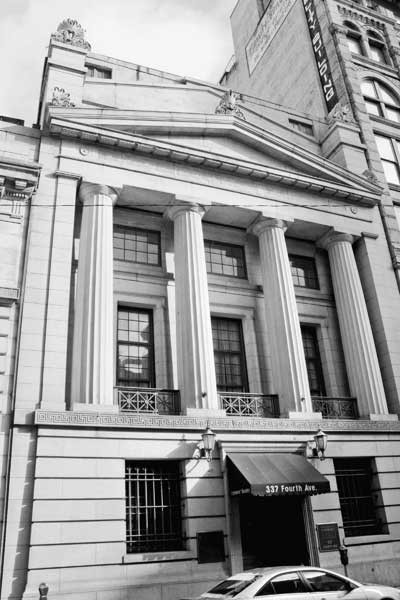
2. Union Station, 1100 Liberty Avenue, 1898-1902 (now The Pennsylvanian). Photo by Todd Tondera.
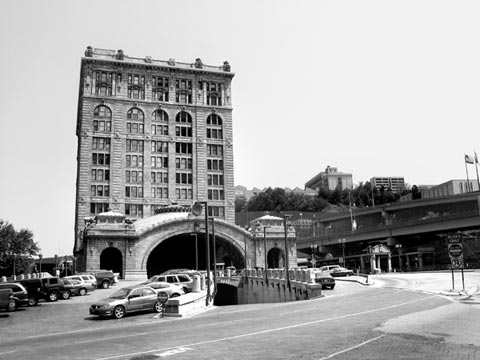
3. Western Pennsylvania Exposition Society Building, Duquesne Way, 1901 (Music Hall [right] demolished 1941; Main Building [left] demolished 1951).
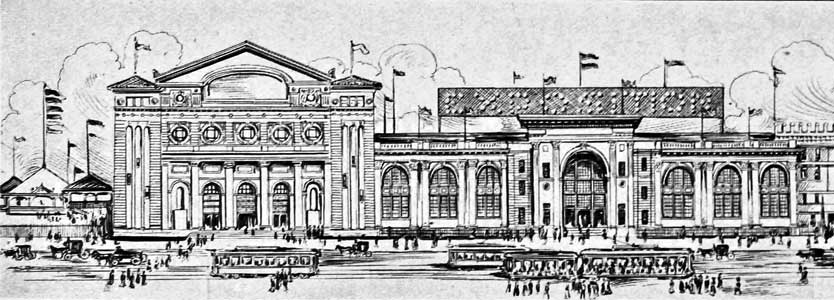
4. Henry Clay Frick Building, 437 Grant Street, 1901-02.
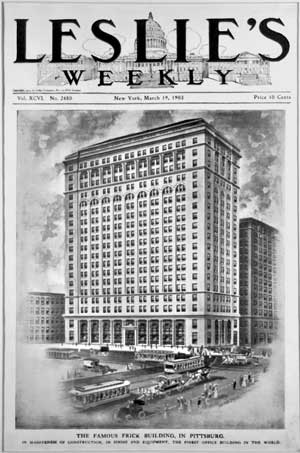
5. Pittsburgh Commercial Gazette, 525-529 Wood Street, c. 1901-03 (demolished 1969).
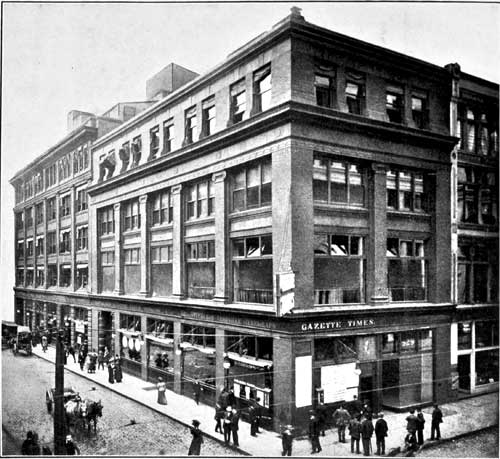
6. Third National Bank, Wood Street at Oliver Avenue, 1903 (demolished 1997).
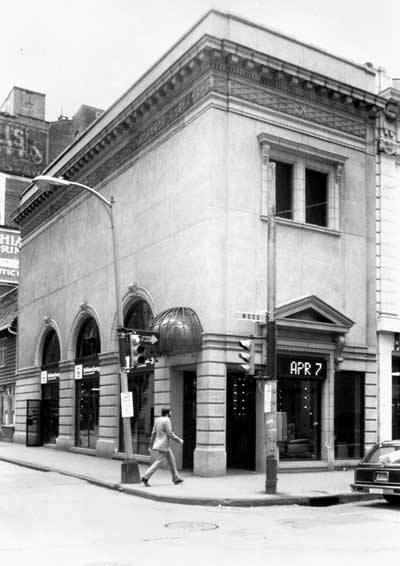
7. Wood Street Building, 528-542 Wood Street, 1902-04. McCreery & Company was its first tenant, opening in 1904. The department store closed in 1938 and the building was altered 1939 and after; It is now 300 Sixth Avenue Building.
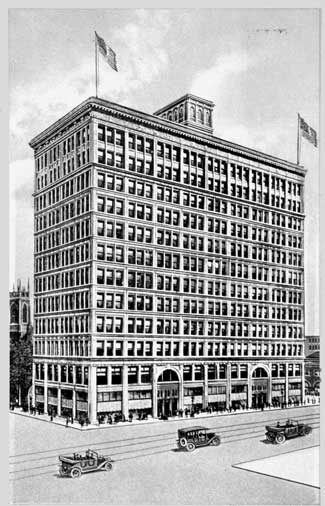
8. Frick Annex, 439 Forbes Avenue, 1905 (now the Allegheny Building). Photo by Todd Tondera.
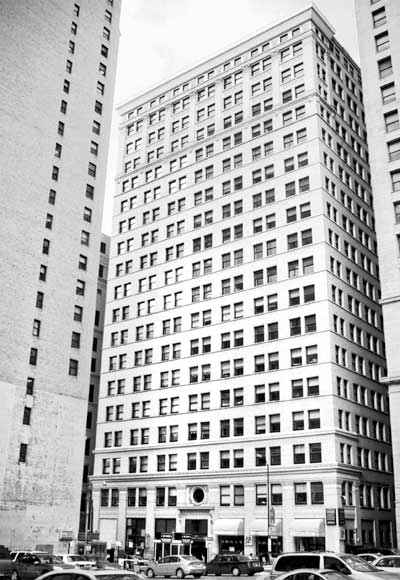
9. Henry W. Oliver Building, 535 Smithfield Street, 1907-10. Photo by Todd Tondera.
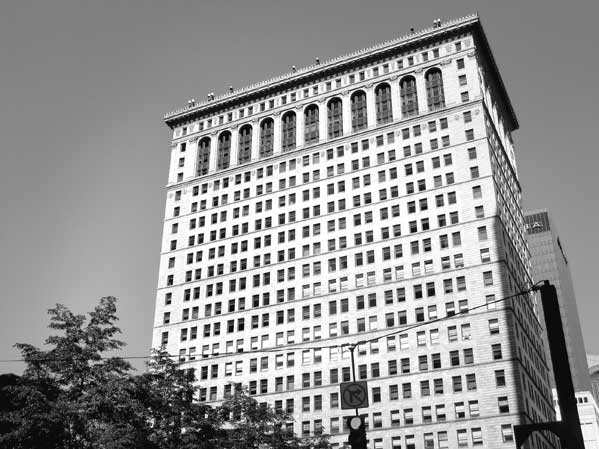
10. Highland Building, 121 South Highland Avenue, 1909-10. Rendering courtesy Archives of Industrial Society, University of Pittsburgh.
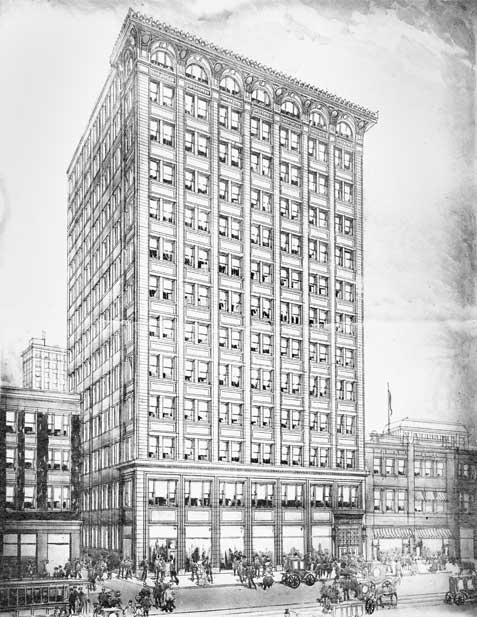
11. First National Bank, Fifth Avenue at Wood Street, 1909; enlarged to 22 stories in 1912 (demolished 1969).
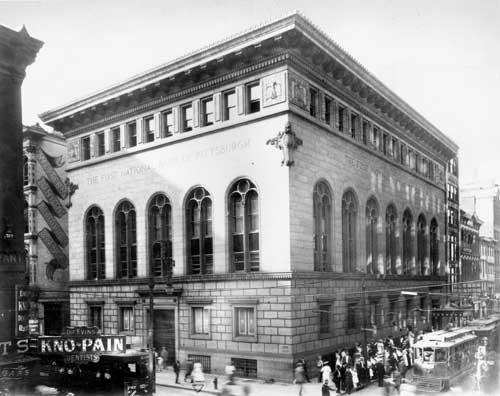
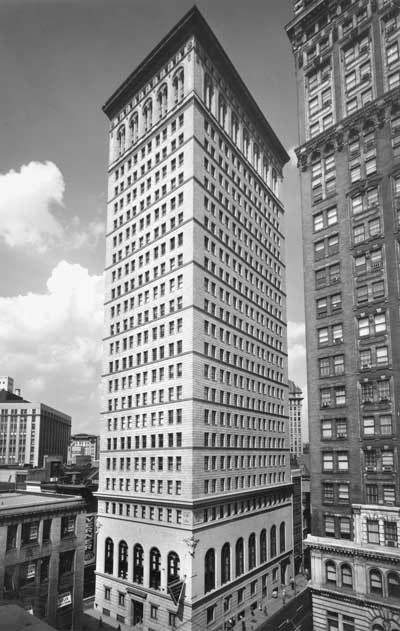
Additional Selected Sources:
Records of the Pittsburgh Department of Public Safety, Bureau of Building Inspection 1877-1928. Archives of Industrial Society, University of Pittsburgh.
Henry W. Oliver Died at 2:00 0’Clock This Morning,” Pittsburgh Dispatch, 8 February 1904, Oliver Iron and Steel Company Records, Archives of Industrial Society, University of Pittsburgh.
Robert Trimble,” Pittsburgh Business Proclamation Number, The Index, 1903, 113.
Residence of Mr. Thomas Rodd, Ellsworth Avenue.” George H. Gall, Homes and Country Estates of Pittsburgh Men (Pittsburgh 1905), n.p.
Chappell, Sally. Architecture and Planning of Graham, Anderson, Probst and White, 1912-1936: Transforming Tradition. Chicago: University of Chicago Press, 1992.
Adapted and abridged from Albert M. Tannler, “D. H. Burnham & Company in Pittsburgh,” PHLF News 175 (April 2009): 16-21.
Albert M. Tannler has been Historical Collections Director of the Pittsburgh History & Landmarks Foundation since January 1991. He oversees the James D. Van Trump Library and the Fairbanks Rail Transportation Archive. Many of his articles about the history of architecture and the decorative arts in Western Pennsylvania have appeared in PHLF News and the Pittsburgh Tribune-Review Focus Magazine.He is the author of Allegheny County Courthouse and Jail Walking Tour (2007), A List of Buildings and Architects in Pittsburgh and Allegheny County 1950-2005, 3rd edition (2005), Pittsburgh’s Landmark Architecture 1785-1950: A Concise Bibliography (1994), and he contributed to African American Architects: A Biographical Dictionary 1865-1945 (2004).He has explicated what critic Patricia Lowry has called “Pittsburgh’s great treasury of historic stained glass” in Charles J. Connick: His Education and His Windows in and near Pittsburgh (2008), William Willet in Pittsburgh 1897-1913: A Research Compendium (2005), and in articles in The Journal of Stained Glass, Connick Windows, and Stained Glass. He has lectured for the Decorative Arts Trust’s Pittsburgh Symposium and at the Frick Art & Historical Center, Pittsburgh, the Charles J. Connick Stained Glass Foundation Ltd., Boston, and the Back Bay Historical Society, Boston.
